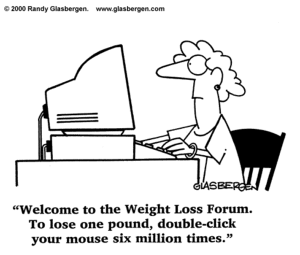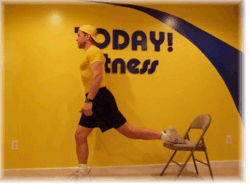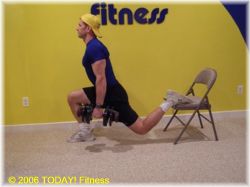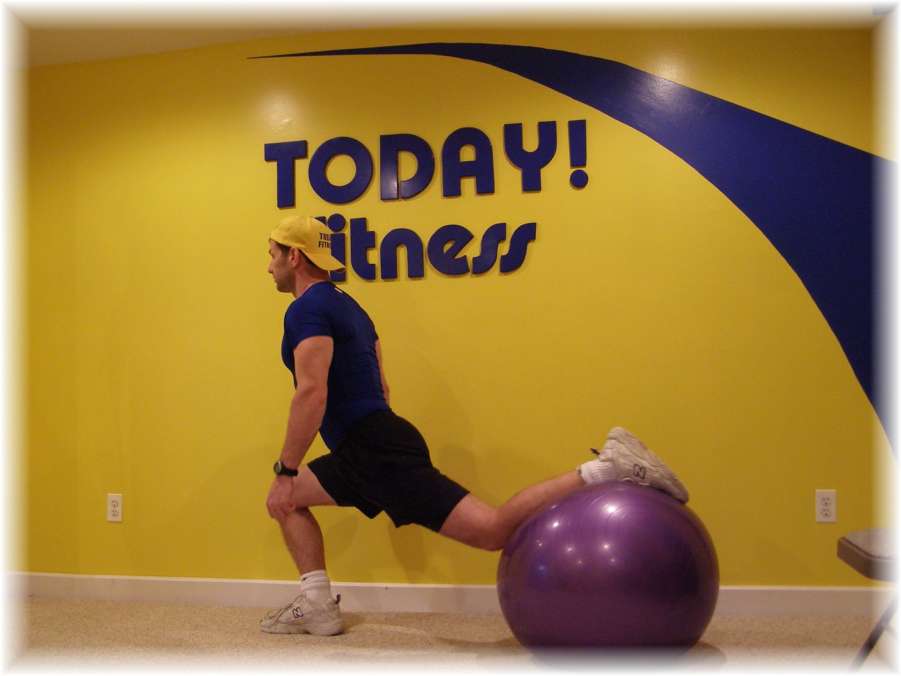|
Warm-up /
Cool-down |
|
Ok, I know you want to get right
to that treadmill, or just start pumping out some reps in the
weight room, but it is important to start at the beginning of
the workout where you are supposed to. Too often, people
bypass the warm-up, stretching, and cool-down periods of their
workout because they want to get right to the "fun stuff".
This mentality not only creates a greater risk of injury, but
can cheat you out of many of the physiological benefits
associated with these vital stages in your exercise session.
The warm up should consist
of graduated aerobic
warm-up activity as well as flexibility exercise specific to
the biomechanical nature of the primary conditioning
activity. Activities
should gradually increase the heart rate, blood pressure,
oxygen consumption, dilation of the blood vessels, elasticity
of the active muscles, and the heat produced by the active
muscle groups.
The flexibility exercise
(pre-stretch), in preparation for activity, is aimed at
decreasing tissue stiffness, focusing particularly on the
muscles that will be used in the activity to follow.
Stretching after exercise may also enhance muscle relaxation,
facilitating normal resting length, circulation to structures,
and removal of unwanted waste products.
The cool-down prevents
post exercise venous blood pooling and too rapid a drop in
blood pressure thereby reducing the likelihood of post
exercise lightheadedness or fainting. It reduces the
immediate post exercise tendency for muscle spasm or
cramping. The cool-down also reduces the concentration of
exercise hormones that are at relatively high levels
immediately after vigorous aerobic exercise. This reduction
will lower the probability of post exercise disturbances in
cardiac rhythm.
 |
|
The Starting Line |
Well, before you get too far along
in you "lifestyle change", you might want to keep track of
where you are first. Heck, you might not recognize the "old
you" next year! For many people, they simply step on the scale
and then watch the numbers each week or each day. Aside from
being VERY frustrating, these numbers don't tell you the whole
story. For starters, body weight doesn't tell you anything
about body fat or muscle density. For people that have been
previously sedentary, your weight may not drop significantly
at the beginning of an exercise program. Although you will
probably be burning body fat, an increase in muscle could make
those numbers on the scale give you the wrong picture.
If you don't have a personal trainer to do it for you, get out
a piece of paper and start a log of your body composition
statistics. If you are seriously committed to big changes, you
may even want to take a "before picture" of what you look like
right now! In addition to checking your body weight, there are
a few more stats that you can track to better judge your
progress:
Circumference measurements: These measurements will give you a
picture of how your body is responding to your exercise
program and where the changes are taking place.
Body Fat: The most effective and practical means of testing
body fat is by having a skin fold test performed on you using
body fat calipers. These calibrated "pinching" devices measure
the amount of fat under the skin and apply the measurement to
a formula to compute the percentage of body fat. By taking
measurements at several points on your body (ie. arm, waist,
thigh) a personal trainer can tell you what percentage of your
body is fat, how many pounds are fat and how many pounds are
lean weight, and how many "fat pounds" you should lose to
facilitate meeting your fitness goals.
Even though your goals may revolve around the way you look,
the benefits of an exercise program will go further than that.
Fitness tests can, and should, also be performed to measure
flexibility, muscle endurance, muscle strength and aerobic
response. These attributes can add to your longevity and
quality of life... as well as make you feel GREAT!
| |
|
Elite
Bodyweight Exercise of the Month! |
|
1 Leg Split Squat

Target:
Legs
(quadriceps & gluteus)
Count: 2
count
Description: Starting
in the up position, with your back leg on a chair or bench.
Working leg should be forward enough so that your knee does
not go past your toes in the down position. Lower your
non working knee towards the floor and then press back up.
Variations include adding weights to your hands for added
resistance, supporting your non-working leg on a stability
ball for more emphasis on core, or any combination of both.
When using the stability ball, start with the top of your foot
on the ball and roll the ball backwards on the downward motion
of the exercise.
 
|
|
NEW SERVICE:
online personal training |
|
The Online
Personal Trainer service at TODAY! Fitness offers a complete
exercise-training program with the convenience of a self paced
alternative. The programs can be tailored to fit your
exercise goals as well as your equipment availability. Even
if you do not have access to equipment, a full workout can be
accomplished using only your bodyweight. The service is
comprehensive and follows a similar format to that of a
standard training session.
All correspondence is done
through a combination of online web pages and email
communication. After completing the online questionnaire
for medical history, exercise history and fitness goals, the
correspondence will walk you through basic body composition
measurements, fitness testing, and goal evaluation. Once
the results are received and reviewed, a customized program
will be sent to you complete with visual representations of
each exercise... much like the ones represented below.
Email correspondence (24hour response time) for questions or
alternative exercises are available to subscribers throughout
the month. Follow-up is performed weekly with requests
for exercise feedback and inquiries in regards to necessity
for program change as well as evaluation of progress.
Click here to find out more
about the new online training service.
|
|
It's
Go Time! |
| 3 issues
down so far... so am I boring you yet? If so, you can
simply just send me an email and I'll take you off the
distribution list. Hey, I'm having fun with it, and if the
information in the newsletter is helpful to at least 1 person,
then I'm ok with that. Sometimes it's the lack of
education and the fear of starting something that cause people
to procrastinate on engaging in an exercise program. I am
hoping that the content in these newsletters is beneficial as
well as educational to some of you. You can review prior
issues of this newsletter on my website at www.todayfitness.net/news.
Your input in regards to format, content, or anything relevant
is always welcome. Just shoot me an email with your
suggestions or comments and I will take them into
consideration.
If you would like to add someone to
this distribution list, please send an email to news@todayfitness.net
and include their name and email address. Likewise, if
you would like to be removed from this distribution list,
please state this in an email to the same address.
Well... it's getting late.
I have to get to bed so that I can wake up at 5am to work out.
Hey, with a 5 year old at home it is the easiest time for me
to get it done without feeling guilty about it. Like I
said, if it's important to you, you CAN make time for it!
Next excuse?
Good Luck!
Pete
Mazzeo
pmazzeo@todayfitness.net
"You only fail when you stop trying" | |
![]()
